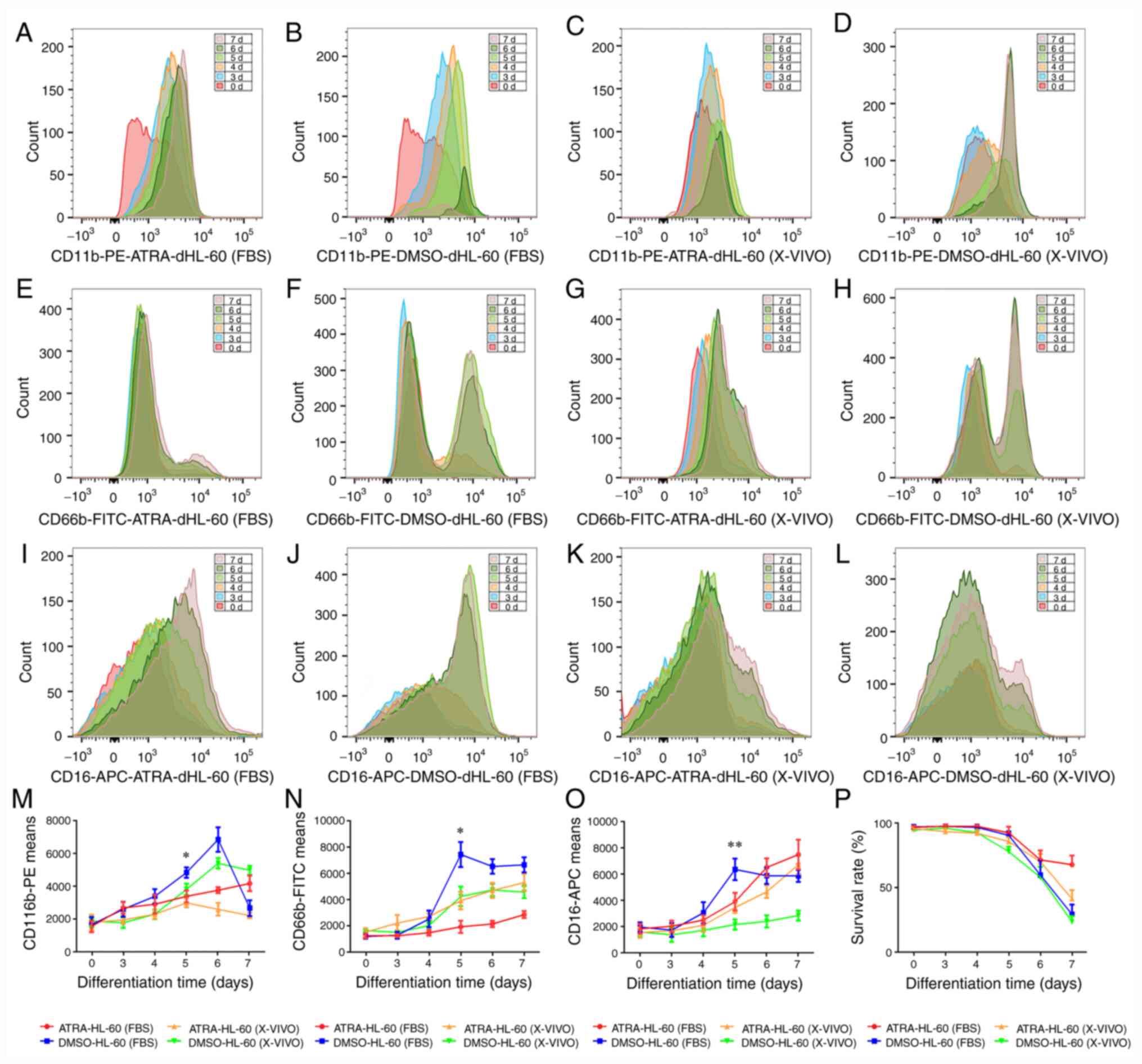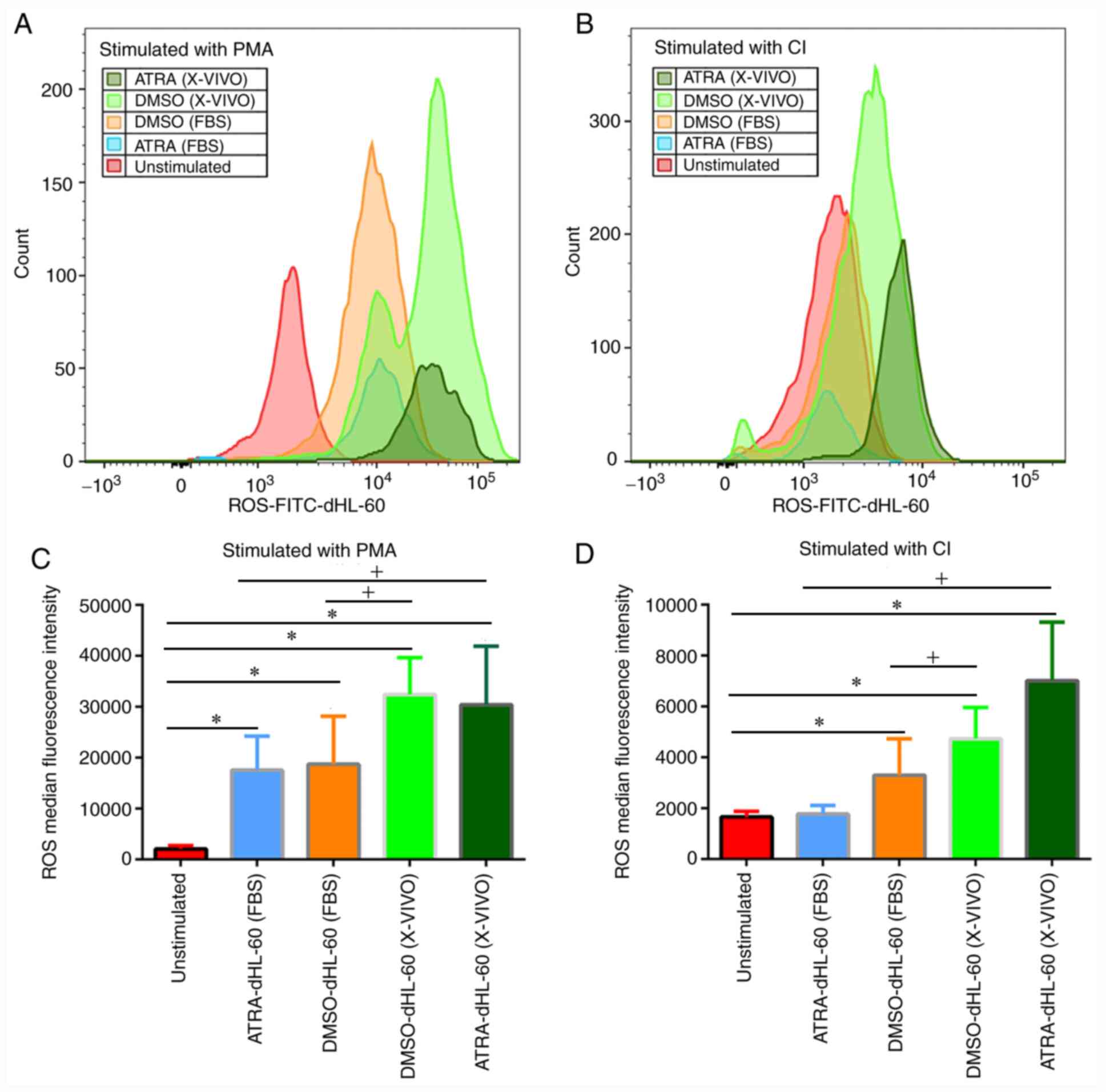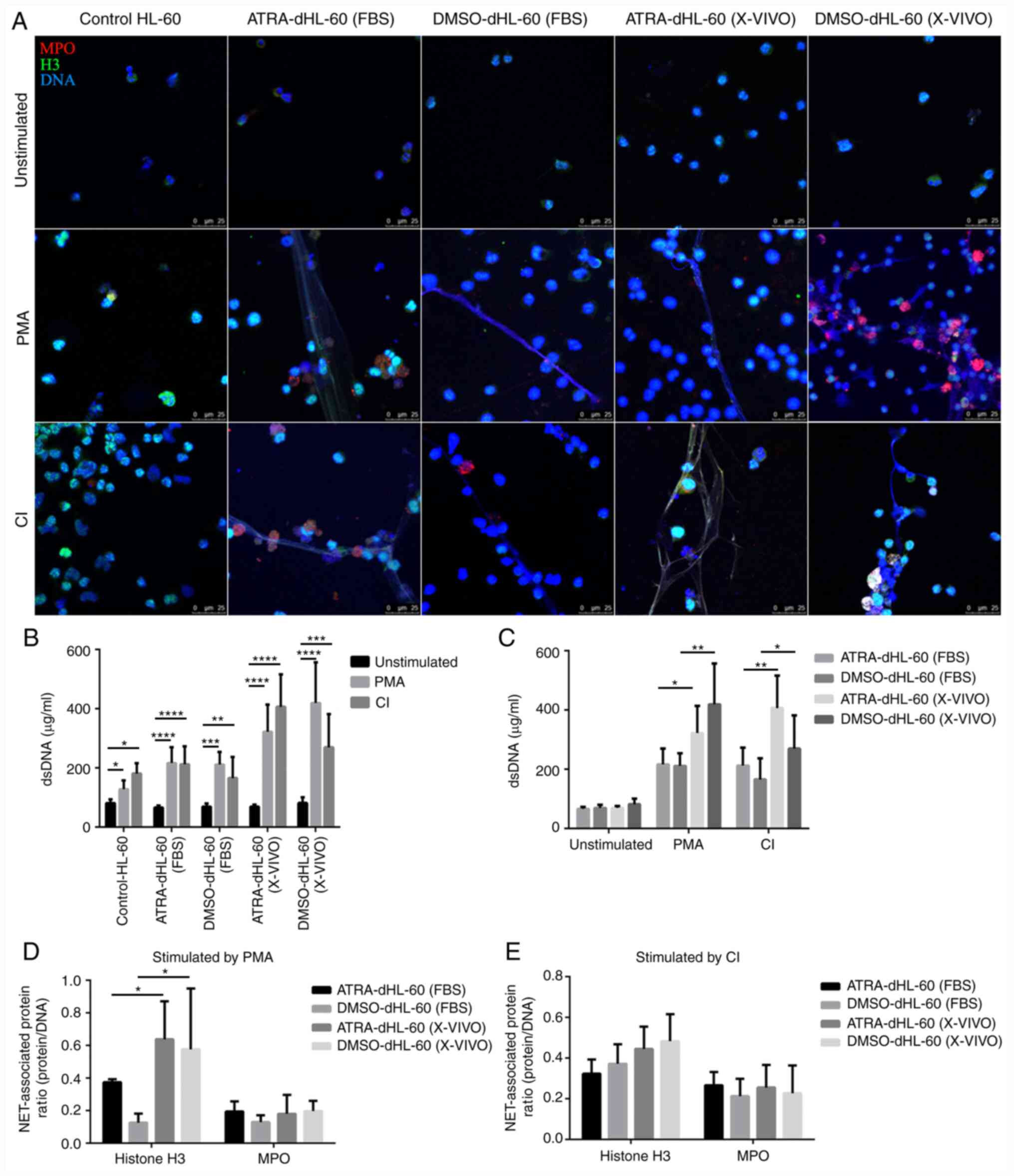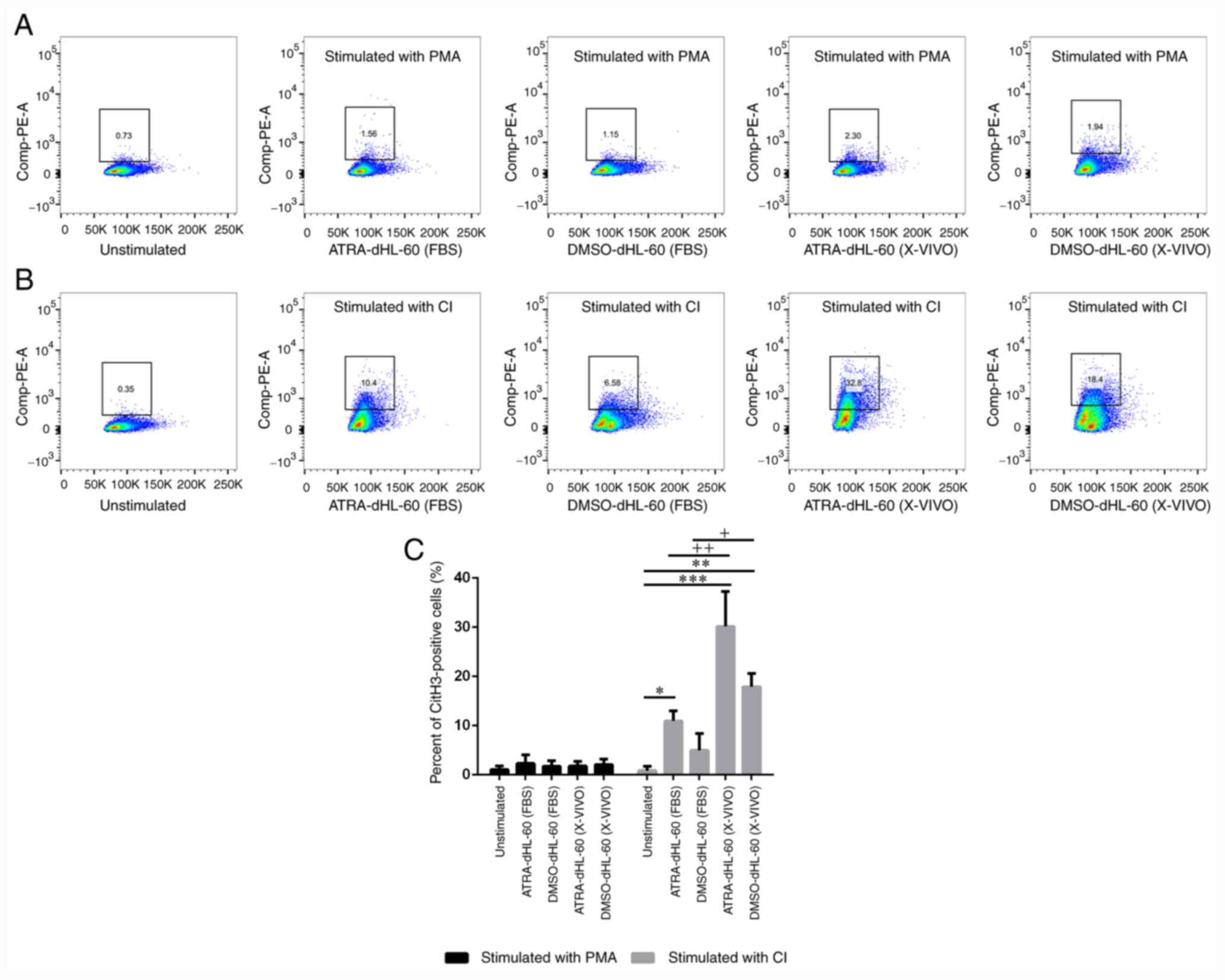|
1
|
Soehnlein O, Steffens S, Hidalgo A and
Weber C: Neutrophils as protagonists and targets in chronic
inflammation. Nat Rev Immunol. 17:248–261. 2017.PubMed/NCBI View Article : Google Scholar
|
|
2
|
Castanheira FVS and Kubes P: Neutrophils
and NETS in modulating acute and chronic inflammation. Blood.
133:2178–2185. 2019.PubMed/NCBI View Article : Google Scholar
|
|
3
|
Lefrancais E, Mallavia B, Zhuo H, Calfee
CS and Looney MR: Maladaptive role of neutrophil extracellular
traps in pathogen-induced lung injury. JCI Insight.
3(e98178)2018.PubMed/NCBI View Article : Google Scholar
|
|
4
|
Mohanty T, Fisher J, Bakochi A, Neumann A,
Cardoso JFP, Karlsson CAQ, Pavan C, Lundgaard I, Nilson B,
Reinstrup P, et al: Neutrophil extracellular traps in the central
nervous system hinder bacterial clearance during pneumococcal
meningitis. Nat Commun. 10(1667)2019.PubMed/NCBI View Article : Google Scholar
|
|
5
|
Tanaka M, Kinoshita-Daitoku R, Kiga K,
Sanada T, Zhu B, Okano T, Aikawa C, Iida T, Ogura Y, Hayashi T, et
al: Group A streptococcus establishes pharynx infection by
degrading the deoxyribonucleic acid of neutrophil extracellular
traps. Sci Rep. 10(3251)2020.PubMed/NCBI View Article : Google Scholar
|
|
6
|
van Dam LS, Kraaij T, Kamerling SWA,
Bakker JA, Scherer UH, Rabelink TJ, van Kooten C and Teng YKO:
Intrinsically distinct role of neutrophil extracellular trap
formation in antineutrophil cytoplasmic antibody-associated
vasculitis compared to systemic lupus erythematosus. Arthritis
Rheumatol. 71:2047–2058. 2019.PubMed/NCBI View Article : Google Scholar
|
|
7
|
Brinkmann V, Reichard U, Goosmann C,
Fauler B, Uhlemann Y, Weiss DS, Weinrauch Y and Zychlinsky A:
Neutrophil extracellular traps kill bacteria. Science.
303:1532–1535. 2004.PubMed/NCBI View Article : Google Scholar
|
|
8
|
Fuchs TA, Abed U, Goosmann C, Hurwitz R,
Schulze I, Wahn V, Weinrauch Y, Brinkmann V and Zychlinsky A: Novel
cell death program leads to neutrophil extracellular traps. J Cell
Biol. 176:231–241. 2007.PubMed/NCBI View Article : Google Scholar
|
|
9
|
D'Cruz AA, Speir M, Bliss-Moreau M,
Dietrich S, Wang S, Chen AA, Gavillet M, Al-Obeidi A, Lawlor KE and
Vince JE: The pseudokinase MLKL activates PAD4-dependent NET
formation in necroptotic neutrophils. Sci Signal.
11(eaao1716)2018.PubMed/NCBI View Article : Google Scholar
|
|
10
|
Yousefi S, Mihalache C, Kozlowski E,
Schmid I and Simon HU: Viable neutrophils release mitochondrial DNA
to form neutrophil extracellular traps. Cell Death Differ.
16:1438–1444. 2009.PubMed/NCBI View Article : Google Scholar
|
|
11
|
Pilsczek FH, Salina D, Poon KK, Fahey C,
Yipp BG, Sibley CD, Robbins SM, Green FH, Surette MG, Sugai M, et
al: A novel mechanism of rapid nuclear neutrophil extracellular
trap formation in response to Staphylococcus aureus. J Immunol.
185:7413–7425. 2010.PubMed/NCBI View Article : Google Scholar
|
|
12
|
Chen KW, Monteleone M, Boucher D,
Sollberger G, Ramnath D, Condon ND, von Pein JB, Broz P, Sweet MJ
and Schroder K: Noncanonical inflammasome signaling elicits
gasdermin D-dependent neutrophil extracellular traps. Sci Immunol.
3(eaar6676)2018.PubMed/NCBI View Article : Google Scholar
|
|
13
|
Manda-Handzlik A, Bystrzycka W, Wachowska
M, Sieczkowska S, Stelmaszczyk-Emmel A, Demkow U and Ciepiela O:
The influence of agents differentiating HL-60 cells toward
granulocyte-like cells on their ability to release neutrophil
extracellular traps. Immunol Cell Biol. 96:413–425. 2018.PubMed/NCBI View Article : Google Scholar
|
|
14
|
Manda-Handzlik A, Bystrzycka W, Cieloch A,
Glodkowska-Mrowka E, Jankowska-Steifer E, Heropolitanska-Pliszka E,
Skrobot A, Muchowicz A, Ciepiela O, Wachowska M and Demkow U:
Nitric oxide and peroxynitrite trigger and enhance release of
neutrophil extracellular traps. Cell Mol Life Sci. 77:3059–3075.
2020.PubMed/NCBI View Article : Google Scholar
|
|
15
|
Obama T, Ohinata H, Takaki T, Iwamoto S,
Sawada N, Aiuchi T, Kato R and Itabe H: Cooperative action of
oxidized low-density lipoproteins and neutrophils on endothelial
inflammatory responses through neutrophil extracellular trap
formation. Front Immunol. 10(1899)2019.PubMed/NCBI View Article : Google Scholar
|
|
16
|
Razvina O, Jiang S, Matsubara K, Ohashi R,
Hasegawa G, Aoyama T, Daigo K, Kodama T, Hamakubo T and Naito M:
Differential expression of pentraxin 3 in neutrophils. Exp Mol
Pathol. 98:33–40. 2015.PubMed/NCBI View Article : Google Scholar
|
|
17
|
Alyami HM, Finoti LS, Teixeira HS, Aljefri
A, Kinane DF and Benakanakere MR: Role of NOD1/NOD2 receptors in
Fusobacterium nucleatum mediated NETosis. Microb Pathog. 131:53–64.
2019.PubMed/NCBI View Article : Google Scholar
|
|
18
|
Douda DN, Khan MA, Grasemann H and
Palaniyar N: SK3 channel and mitochondrial ROS mediate NADPH
oxidase-independent NETosis induced by calcium influx. Proc Natl
Acad Sci USA. 112:2817–2822. 2015.PubMed/NCBI View Article : Google Scholar
|
|
19
|
Gavillet M, Martinod K, Renella R, Harris
C, Shapiro NI, Wagner DD and Williams DA: Flow cytometric assay for
direct quantification of neutrophil extracellular traps in blood
samples. Am J Hematol. 90:1155–1158. 2015.PubMed/NCBI View Article : Google Scholar
|
|
20
|
Rincon E, Rocha-Gregg BL and Collins SR: A
map of gene expression in neutrophil-like cell lines. BMC Genomics.
19(573)2018.PubMed/NCBI View Article : Google Scholar
|
|
21
|
Liu CL, Tangsombatvisit S, Rosenberg JM,
Mandelbaum G, Gillespie EC, Gozani OP, Alizadeh AA and Utz PJ:
Specific post-translational histone modifications of neutrophil
extracellular traps as immunogens and potential targets of lupus
autoantibodies. Arthritis Res Ther. 14(R25)2012.PubMed/NCBI View
Article : Google Scholar
|
|
22
|
Gupta D, Shah HP, Malu K, Berliner N and
Gaines P: Differentiation and characterization of myeloid cells.
Curr Protoc Immunol. 104:22F.5.1–22F.5.28. 2014.PubMed/NCBI View Article : Google Scholar
|
|
23
|
Pedruzzi E, Fay M, Elbim C and
Gougerot-Pocidalo MA: Differentiation of PLB-985 myeloid cells into
mature neutrophils, shown by degranulation of terminally
differentiated compartments in response to N-formyl peptide and
priming of superoxide anion production by granulocyte-macrophage
colony-stimulating factor. Br J Haematol. 117:719–726.
2002.PubMed/NCBI View Article : Google Scholar
|
|
24
|
Chen L, Xie XY, Nie JQ, Chen DL, Huang AP,
Fang F, Qu MY, Nan X, He LJ, Fan Z, et al: Mononuclear cells of
umbilical cord blood differentiation to granulocyte cell in vitro.
Zhonghua Xue Ye Xue Za Zhi. 38:532–536. 2017.PubMed/NCBI View Article : Google Scholar : (In Chinese).
|
|
25
|
Perdomo J, Leung HH, Ahmadi Z, Yan F,
Chong JJ, Passam FH and Chong BH: Neutrophil activation and NETosis
are the major drivers of thrombosis in heparin-induced
thrombocytopenia. Nat Commun. 10(1322)2019.PubMed/NCBI View Article : Google Scholar
|
|
26
|
Lelliott PM, Momota M, Shibahara T, Lee
MS, Smith NI, Ishii KJ and Coban C: Heparin induces neutrophil
elastase dependent vital and lytic NET formation. Int Immunol.
32:359–368. 2020.PubMed/NCBI View Article : Google Scholar
|
|
27
|
Lood C, Blanco LP, Purmalek MM,
Carmona-Rivera C, De Ravin SS, Smith CK, Malech HL, Ledbetter JA,
Elkon KB and Kaplan MJ: Neutrophil extracellular traps enriched in
oxidized mitochondrial DNA are interferogenic and contribute to
lupus-like disease. Nat Med. 22:146–153. 2016.PubMed/NCBI View
Article : Google Scholar
|
|
28
|
Burgener SS and Schroder K: Neutrophil
extracellular traps in host defense. Cold Spring Harb Perspect
Biol. 12(a037028)2020.PubMed/NCBI View Article : Google Scholar
|
|
29
|
Wang Y, Li M, Stadler S, Correll S, Li P,
Wang D, Hayama R, Leonelli L, Han H, Grigoryev SA, et al: Histone
hypercitrullination mediates chromatin decondensation and
neutrophil extracellular trap formation. J Cell Biol. 184:205–213.
2009.PubMed/NCBI View Article : Google Scholar
|
|
30
|
Yaseen R, Blodkamp S, Lüthje P, Reuner F,
Völlger L, Naim HY and von Köckritz-Blickwede M: Antimicrobial
activity of HL-60 cells compared to primary blood-derived
neutrophils against Staphylococcus aureus. J Negat Results Biomed.
16(2)2017.PubMed/NCBI View Article : Google Scholar
|
|
31
|
Sham RL, Phatak PD, Belanger KA and
Packman CH: Functional properties of HL60 cells matured with
all-trans-retinoic acid and DMSO: Differences in response to
interleukin-8 and fMLP. Leuk Res. 19:1–6. 1995.PubMed/NCBI View Article : Google Scholar
|
|
32
|
Song G, Shi L, Guo Y, Yu L, Wang L, Zhang
X, Li L, Han Y, Ren X, Guo Q, et al: A novel PAD4/SOX4/PU.1
signaling pathway is involved in the committed differentiation of
acute promyelocytic leukemia cells into granulocytic cells.
Oncotarget. 7:3144–3157. 2016.PubMed/NCBI View Article : Google Scholar
|
|
33
|
Imaizumi M and Breitman TR: Retinoic
acid-induced differentiation of the human promyelocytic leukemia
cell line, HL-60, and fresh human leukemia cells in primary
culture: A model for differentiation inducing therapy of leukemia.
Eur J Haematol. 38:289–302. 1987.PubMed/NCBI View Article : Google Scholar
|
|
34
|
Wang Y, Wysocka J, Sayegh J, Lee YH,
Perlin JR, Leonelli L, Sonbuchner LS, McDonald CH, Cook RG, Dou Y,
et al: Human PAD4 regulates histone arginine methylation levels via
demethylimination. Science. 306:279–283. 2004.PubMed/NCBI View Article : Google Scholar
|
|
35
|
Steinberg SF: Structural basis of protein
kinase C isoform function. Physiol Rev. 88:1341–1378.
2008.PubMed/NCBI View Article : Google Scholar
|
|
36
|
Remijsen Q, Vanden Berghe T, Wirawan E,
Asselbergh B, Parthoens E, De Rycke R, Noppen S, Delforge M,
Willems J and Vandenabeele P: Neutrophil extracellular trap cell
death requires both autophagy and superoxide generation. Cell Res.
21:290–304. 2011.PubMed/NCBI View Article : Google Scholar
|
|
37
|
Parker H, Dragunow M, Hampton MB, Kettle
AJ and Winterbourn CC: Requirements for NADPH oxidase and
myeloperoxidase in neutrophil extracellular trap formation differ
depending on the stimulus. J Leukoc Biol. 92:841–849.
2012.PubMed/NCBI View Article : Google Scholar
|
|
38
|
Kamoshida G, Kikuchi-Ueda T, Nishida S,
Tansho-Nagakawa S, Kikuchi H, Ubagai T and Ono Y: Spontaneous
formation of neutrophil extracellular traps in serum-free culture
conditions. FEBS Open Bio. 7:877–886. 2017.PubMed/NCBI View Article : Google Scholar
|
|
39
|
Hakkim A, Furnrohr BG, Amann K, Laube B,
Abed UA, Brinkmann V, Herrmann M, Voll RE and Zychlinsky A:
Impairment of neutrophil extracellular trap degradation is
associated with lupus nephritis. Proc Natl Acad Sci USA.
107:9813–9818. 2010.PubMed/NCBI View Article : Google Scholar
|


















